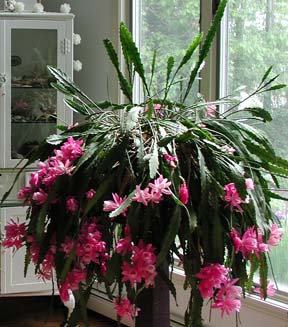
When it comes to watering, it helps to know an individual plant’s preferences. Although this epiphyllum is commonly called an “orchid cactus” it does not like to go completely dry, but needs regular, thorough soakings.
When someone comes into the garden center carrying a container plant that’s in distress, I ask, “What has the watering been like?” This is my first question because I am convinced that the majority of people who claim to have a brown thumb just don’t know how to water.
Be it a houseplant, outdoor pot of annuals, or even a small, containerized tree, the guidelines for watering are the same.
First, check the moisture in the pot by sticking your finger into the soil, pushing it into the potting mix if possible. If the soil feels damp, don’t water the plant yet. If the soil-surface feels dry, but before the plant starts to wilt from thirst, soak the pot until the water starts coming out the drainage hole underneath.
If the soil was so dry that it has pulled away from the sides of the pot (this happens most often with containers that are outdoors in the sun) wait a minute after the first watering to give the soil time to swell a bit, then give the plant a good second soaking. The first time you water, a good deal of the water runs down the space between the root-ball and the pot, so a repeat soaking insures that the moisture penetrates all of the soil around the roots.
If your pots are sitting in a saucer, the excess water is bound to collect there, and this is a sign that you’ve giving the plant a good soaking. Leave the water in the saucer for an hour or two, and some it will be absorbed back into the pot. If the water is still there after a couple of hours, empty it out by tipping the plant, using an old towel to absorb it, or a turkey baster to pull it out of the saucer.

This collection of shade-lovers does not need watering every day, but the begonia on the top is so large, and probably root-bound in its pot, that the soil should be checked frequently.
Now this sounds pretty simple, right? Feel the soil, and if it’s dry, water it deeply, pause, and water again. Don’t let the pot sit in a dish of water for very long, and wait until the soil feels dry before watering again. So where do people go wrong?
Sometimes they forget to feel the soil, and assume that the plant needs water. Too much water will rot a plant’s roots. A plant with rotted roots looks wilted, just as a thirsty one does, because the rotted roots can’t carry water up to the leaves.
Another way people fail is to give the plant a small amount of water very frequently; the problem with this approach is that it does not get the entire pot of dirt wet. The roots that are at the bottom of the pot dry up while the crown of the plant is being kept constantly moist. A plant treated to such frequent, shallow soakings is likely to wilt from dried roots and crown rot.
And there are those who let the soil get too dry, mainly because they forget to check the pot often enough. In hot, sunny locations, outdoor plants in containers may need watering once a day, and the smaller the container, the faster it will dry out. In cooler temperatures or shadier spots, however, your pots and boxes might be fine without watering for several days at a time.
So if your container plants are in distress, the first question to ask yourself is “What’s the watering been like?”
